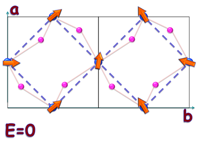The following is the summary of a group paper recently accepted to be published in Physical Review Letters:
In most materials electricity and magnetism do not strongly interact so that mixed magneto-electric devices are not yet a part of the electronics industry. Similarly, the electromagnetic response (i.e., to light) is generally separate – the magnetic field of light can excite magnetic resonances and light’s electric field can excite lattice vibrations. In multiferroic materials, where magnetism and ferroelectricity coexist, it is possible to excite mixed spin and lattice vibrations with electromagnetic waves. These excitations are called electromagnons.
Based on a study of the absorption spectrum of the multiferroic compound TbMnO3 as a function of magnetic field, temperature, and polarization of light we propose a theory for the origin of these electromagnon excitations in the whole multiferroic family RMnO3. Interestingly, we find that the mechanism responsible for electromagnons is different from the one that couples static magnetism and ferroelectricity. Our model also explains the appearance of ferroelectricity in another family of multiferroic materials with collinear magnetic structures - the so called E-phase. Our results show how to strongly couple spin and lattice excitations, and that this mechanism can exist in non-multiferroic materials. Therefore, in principle, this effect could be useful for spintronic applications that take advantage of this coupling even at room temperature, something that is not possible in the current families of multiferroic materials where these effects exist only at cryogenic temperatures.
|
 
|
1.“The origin of electromagnon excitations in multiferroic RMnO3” R. Valdes Aguilar, M. Mostovoy, A. B. Sushkov, C. L. Zhang, Y. J. Choi, S-W. Cheong, and H. D. Drew, Physical Review Letters, to be published. |





